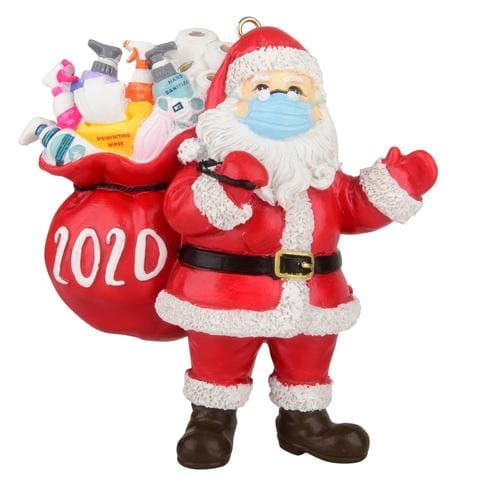
As a successful Amazon seller, I learned the hard way how to fight Amazon scam pirates.
There are many things you need to know if you want to be successful selling on Amazon.
But I am happy to pass along the wisdom I’ve gained by battling Amazon scam pirates in this case study.
Note: I took what I have learned as an Amazon seller and written an article for Amazon buyers called 6 Ways to Avoid Getting Scammed on Amazon Purchases.
Success Attracts Amazon Scammers
Did you ever wonder what it would be like to come up with a product that is crazy successful and goes viral?
I did. And it turns out that it was one of the most stressful experiences of my life.
One of the things that makes selling on Amazon difficult is that success is punished at every turn.
For example, when a product starts selling quickly Amazon will inevitably ‘re-measure’ that product in a way that allows them to increase their fees.
But potentially more devastating is the fact that it’s not just Amazon that attacks you when you start selling a lot of product. You’ll also gain the attention of Amazon scam pirates.
People who want to sell items on Amazon typically use tools like Jungle Scout and IO Scout to identify products that are selling fast at a high profit. But so do the Amazon scam pirates!
And these pirates are unscrupulous. They will steal your photos, scrape all the data from your listing, and set up listings selling the ‘same’ product as yours for a fraction of the price.
And then, after undercutting your price, they will ship a piece of junk from China that looks nothing like your product.
This is exactly what happened to me. And I felt helpless.
But then I got smart and fought back.
Here is how.
Amazon Scam Pirates Case Study: 2020 COVID Santa Claus
My experience with Amazon Scam Pirates was horrible and heart breaking.
But I learned a lot. So read on!
Inspiration
In April 2020 my husband Matt and I were in quarantine along with the rest of the world.
And as an Amazon FBA seller, my entire business came to an abrupt stop.
Amazon had restricted inventory to only ‘essential products’ and non-essential products already in stock were showing 4 weeks+ delivery times.
Sales of my products on Amazon were non-existent.
Like a lot of people I handled the first month or two of quarantine by sleeping, eating, and drinking a lot.
I wasn’t productive and I certainly wasn’t designing new products. Think about it – I couldn’t send any new items in to Amazon to sell. And I had NO idea if this would last a month, a year, or 2 years.
I certainly wasn’t going to invest my time or money into new inventory. And since e-commerce was my main income/job at this point, I pretty much didn’t do anything productive for two months.
But then one day, while surfing Facebook, I came across a post of someone who was asking if anyone had seen any cute/classy Christmas tree ornaments.
The original poster said that she’d already seen a roll of toilet paper as an ornament, but was looking for something more commemorative of the year. Somehow that post immediately took root with me and I started thinking about it.
A few days later I popped out of the shower and announced to Matt that I had it! My next product would be a Christmas tree ornament – and Santa Claus would be wearing a facemask.
I have a rather slow creative process so I didn’t do much with that but let it percolate for a while.
A few days later I woke up so excited – not only would Santa wear a face mask, but he would have a bag that had ‘gifts’ of toilet paper, hand sanitizer, and face masks!!
Design
I hired two different artists on Fiverr and gave them both my exact same description: Jolly Santa wearing a face mask waving while carrying a sack full of toilet paper, hand sanitizer and disinfecting wipes.
I loved both of the designs, but loved one a bit more.
I made a few changes, and this was the final picture:

Manufacturing
I then set about to finding a manufacturer.
In June I sent the same requirements and pictures to multiple manufacturers on Alibaba. By late June I had pictures of two different samples that I was SO excited about. I had them shipped to the US and I received them both by July 10.
Of the two, I loved the one that was so much more robust. In hindsight it’s heaviness was one of the things some people didn’t like – it was heavy so had to hang on a sturdy Christmas tree branch.
But also in hindsight it was the perfect choice – the flatter ornament looked much more like the cheaper ‘fakes’ that companies eventually produced. My Santa was more difficult and expensive to produce – because it is higher quality.
I decided on an order of 5000 ornaments. But due to price threshold with my supplier I ended up ordering 5500, which saved me money on a per unit basis. I submitted the final agreed-upon PO and paid a deposit in mid-July.
My manufacturer spent August producing the ornaments.
Shipping
Once manufacturing was complete and the product had been inspected, it was time to ship.
Because I needed to have the ornaments to market in time for Q4, it was too late to ship them by sea – especially since COVID had created backlogs at the sea ports.
So I bit the bullet and paid for air shipping, which cost almost twice as much as manufacturing on a per-unit basis!
But by mid-September I had my product ready for market at the start of Q4.
Here’s a picture of the cute little guy!

My Amazon Listing
I was super-excited to get my cute COVID Santa listing to market.
So I had professional photos taken (under a contract where I owned the photos – which is critical to this story), wrote my search optimized listing content, and set up the listing.
You can check it out here:
My 2020 COVID Santa Went Viral
When my Santa listing went live I set the price at $33.99. I figured I’d price it relatively high and sell it at a 25% discount.
I posted a photo of it in a few Christmas-oriented Facebook groups to gauge interest.
And suddenly sales spiked. I sold over 200 Santas in only 2 days in September at full price!
I was so excited. Thrilled. I never thought of myself as a creative type. I’m far more business-oriented.
But I had created something from the inspiration in my mind through design and manufacturing and then brought it to market – and people LOVED it!
I celebrated.
But I should have been preparing for an intellectual property war instead.
How the Drop Shipping Model has Led to Chinese IP Piracy
Drop shipping done properly is a great side-hustle. In fact, it’s one of the ways we recommend making money while traveling.
But unscrupulous Chinese manufacturers have perverted the model to promote Amazon scam piracy.
These manufacturers keep track of selling trends on Amazon. When a product takes off, they steal your photos and listing and offer it to Chinese (and other) drop shipping sellers.
These sellers create listings on Amazon using your photos and content. Then sell the product at a fraction of the price you are charging. Sometimes these sellers know they are ripping off your listing, but sometimes they are just unwittingly using the photos and words that the unscrupulous manufacturer gives them.
Following the drop ship model, the sellers pass any sales back to the manufacturer who produces a piece of junk and ships it to Amazon buyers in a Chinese epacket – meaning the shipping cost is subsidized by the Chinese government.
And that’s why one day in mid-October I woke up and searched for my COVID Santa on Amazon and found this:

Chinese sellers weren’t just selling a similar product.
They had ripped off my photos as well as my listing content. And they were selling what they were claiming was my COVID Santa at a fraction of the price – at a price that would cause me to lose money on every Santa I sold! In fact they were selling FIVE junk Santas for less than my price for one.
My incredible success had turned to a potential financial disaster. Overnight.
I was so angry I was livid.
And I felt hopeless: all my inspiration, creativity and hard work were being stolen in broad daylight. My $20,000 investment was being made worthless!
I cried. A lot.
But there was no time to feel sorry for myself. No time to grieve.
This Santa was MY creation. MY idea. MY product. MY photos. MY listing.
I am a businesswoman, and it was time to act like one.
Taking Stock of the Situation
The first thing I did was to figure out what was happening.
So I turned to the communities of Amazon sellers I know through social media.
I learned what I have told you: that unscrupulous Chinese manufacturers and often-unwitting Chinese (and other) drop shippers were behind this.
And, depressingly, that this is very, very common with successful Amazon products.
Funny Not Funny
Many of the listings by Amazon scam pirates were ridiculous.
And yet some contained a secret threat.
Check this pirate listing out:

That’s clearly not written by a native English speaker.
But take a look at the Chinese characters.
Here they are again in another Amazon pirate scam listing:

I was curious so I Google Translated the characters. Turns out they were a sinister warning:

It’s a threat. If I turn in the pirate they will come after my brand with false claims that could shut me down while they are being resolved.
This was terrifying, quite honestly. It is unfortunate but true – a fake IP claim is as powerful as an honest one. Amazon doesn’t know the difference. This was a seasonal product and if my business was shut down in November and December I would have lost money on my most successful idea ever….insane, right?
DMCA Should be a Powerful Weapon for Legitimate Amazon Sellers
I once again turned to my Amazon seller community. And that’s when I learned about the DMCA.
The Digital Millennium Copyright Act (DMCA) is a 1998 United States copyright law that implements two 1996 treaties of the World Intellectual Property Organization (WIPO).
It criminalizes production and dissemination of technology, devices, or services intended to circumvent measures that control access to copyrighted works (commonly known as digital rights management or DRM).
Critically, the DMCA heightens the penalties for copyright infringement on the Internet.
My Santa isn’t subject to a copyright.
But my photos are!
Under the Federal Copyright Act of 1976, photographs are protected by copyright from the moment of creation. According to the U.S. Copyright Office, the owner of the “work” is generally the photographer or, as in my case, the employer of the photographer – me!
And because of the heightened penalties under DMCA, Amazon should take DMCA takedown notices seriously.
Amazon Ignored my DMCA Takedown Notices
While Amazon should take DMCA takedown notices seriously, in my case they did not.
Amazon Web Services immediately washed their hands of the hosting of my stolen copyrighted photos on Amazon:
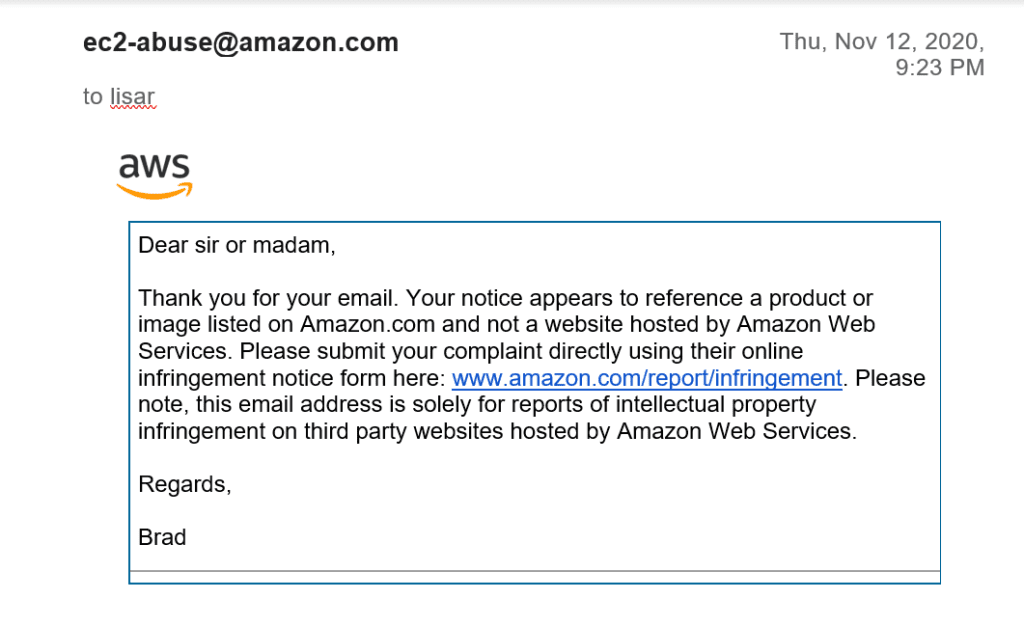
Following ‘Brad’s’ advice, I submitted my complaint directly to Amazon.
But that was the link I’d already been using and got NO reply from for weeks. Sigh.
This is the link that Amazon and everyone else tells you to use. But it is useless when fighting the pirates because Amazon’s response took 4-6 weeks. That’s 4-6 weeks during which pirates were using my photos to scam Amazon customers. Note that my initial copyright complaint above for this particular set of products was on November 12 – and I received a reply from Amazon (they agreed and took down the listing – yay?) on December 11.

The Key to Fighting Amazon Scam Pirates is Brand Registry
Bent but unbroken, I went back to my seller community for more advice.
Finally someone online pointed me to Brand Registry as a mechanism to report copyright violations.
And that changed everything.
To take advantage of Brand Registry protection you must be brand registered. Which means you have to have a trademark on your brand. Which I do. More details here: https://brandregistry.amazon.com/
If you are going to sell on Amazon, you need to be brand registered to protect your brand. Period.
Here’s the Most Effective Way to Fight Amazon Scam Pirates
In Amazon Seller Brand Registry you select ‘Protect’:

And then ‘Report a violation’

From there it’s simple to fill out the details of the copyright violation:

And get the ball rolling on copyright infringement enforcement:

These complaints were addressed quickly by Amazon.
Sometimes within hours. Sometimes within days.
In fact, the biggest issue I had reporting through Brand Registry is that if I had already reported an Amazon scam pirate using the regular link my complaint in Brand Registry was rejected until the original report was closed. Which, again, took 4 to 6 weeks – if they were ever addressed at all.
So the scam sellers I reported from mid-October through early November actually had the longest time to sell and there was nothing I could do about it.

Eternal Vigilance is the Price of Selling on Amazon
Finally armed with an effective weapon against Amazon scam pirates I went well and truly to war with the Amazon scam pirates.
From mid-October until mid-December (8 weeks time) I filed over 1,000 copyright infringements using the Amazon Brand Registry.
That’s about 18 violation reports per day!
It was all I did. I found scam pirates and reported them. All day long.
And it seemed like every time I shut a scam seller down two more popped up. So I had to redouble my efforts.
It’s a hell of a way to live your life.
And, worse, I kept waiting for the sellers to retaliate against me. For them to make good on their threat to go after my brand with false claims.
How Sellers Responded to Having their Product Listing Suspended from Amazon by Me
During this period every day I would wake up to furious emails from Chinese sellers – angry that I had shut down their pirate listing. Using Google Translate, I found I was being called all sorts of names. And being threatened.
But believe it or not, over time I came to have some empathy for some of them.
Many of these sellers were just following the path that the drop shipping ‘gurus’ tell you to follow: find a hot product with a lot of sales and not many sellers , find a manufacturer, buy, use the photos and content provided by the manufacturer.
I realized that many of them had no idea that they were using my intellectual property to sell a scam manufacturer’s junk.
So I replied to these emails explaining that their manufacturer had provided them with MY photos and MY listing content. And that if they wanted me to remove the complaint/suspension all they had to do was stop using my photos.
This face-saving approach worked with most sellers.
But then, of course, they had to use photos of the actual junk that they were selling. Which looked like this (or worse):

These manufacturers and sellers were still ripping off my idea.
But at least they weren’t pretending they were selling MY ornament at a fraction of the price I was charging using MY photos!
What Happens When Amazon Customers Get the Scam Product?
I’m a big believer in the free market. Eventually it outs scams and rip-offs.
The problem is with the word ‘eventually.’
As I say, the junk items were being shipped from China. And shipping from China in epackets takes a month or more. With Christmas a couple of months away, these sellers would only be competitive for about a month before their products would arrive after Christmas. Still, that month would devastate my business model.
Secondly, I knew that these sellers were NOT selling my adorable high-quality Santa. They were actually using my photos and listings to sell whatever junk the unscrupulous Chinese manufacturer put in the epacket. This would result in terrible reviews from Amazon buyers claiming fraud that would eventually sink them as competitors. Eventually.
And that did eventually happen:


But again, by the time these crappy knock-offs arrived and got terrible reviews I would have lost a month or more of sales.
And those crappy reviews might give my REAL product a bad reputation in the marketplace.
Worse, these drop ship sellers carry no actual inventory to support their listing and brand. So when they get bad reviews like the ones above they simply shut the listing down and open up a new one with no reviews and go back to their Amazon scam pirate ways.
In the world of Amazon selling you can’t wait for the free market to do its thing. Doing so lets the bad guys win.
You have to bring the fight directly to the Chinese drop ship sellers and the manufacturers whose stuff they were selling.
And the way to do that is through Amazon Brand Registry.
Bottom Line – Fighting Amazon Scam Pirates
I used to think that creating a great product that goes viral is the end all and be all of FBA e-commerce.
What I learned is that success in the marketplace only invites scammers and pirates.
And Amazon does not make it easy to fight back.
I did. And by Christmas I had nearly sold out of my COVID Santa inventory! Without having to lower my price (I sold 5400 of the 5500 I had purchased as of Jan 1 – a very, very successful one-time seasonal product).
I actually consider myself lucky that my viral product was a one-time, seasonal product because during the most stressful points I had an endgame – sell the 5500 units I had purchased by Christmas for the most money possible. This was a short term product, and I only had 5500 units. Fighting every day to protect it was exhausting. But that’s what you have to do.
So if you are going to sell FBA, take the time to get a trademark and then be Amazon Brand Registered.
I wish you all the best. Like so many, I have a love/hate relationship with Amazon – I have been extremely successful on it but live in (a healthy) fear of it. Good Luck!
Leave a Reply
Recent posts
There are affiliate links in this page, meaning, at no additional cost to you, we will be compensated if you click through and take action.
As an Amazon Associate, we earn from qualifying purchases. We only recommed products and services that we have used and found helpful, so please do click on our links.




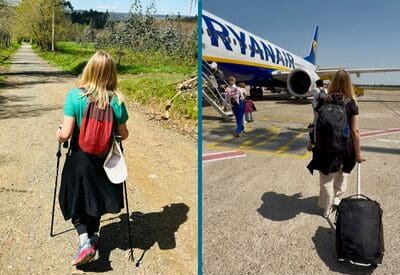

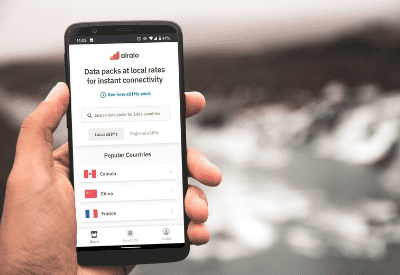
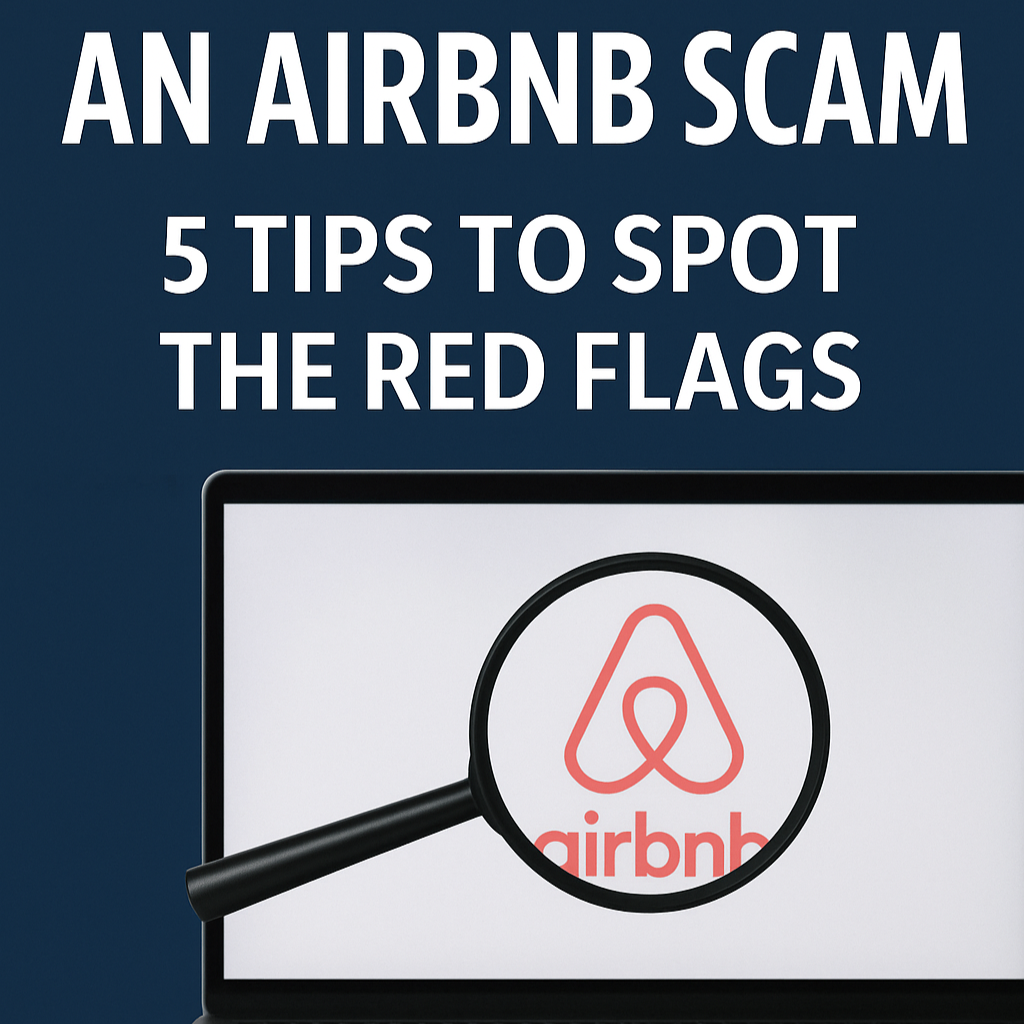






That’s an amazing story Lisa, thank you for sharing the unbelievable experience with other that are having similar problems with Chinese bandits and Amazon’s “slow to respond” mentality, even though people are suffering daily at the hands of so many unscrupulous low-lifes in China. Very glad to hear that you beat them up and left the crying in the gutter as you shipped your 5400 ornaments and made a profit on your creativity, determination and victory.
Hi, i read this article like an action movie! At some parts ‘Eye of the tiger’ played in my head! Lol :))
May i ask, how long does it took to get trademark and brand register process? I m new on amazon and i’m gonna try to sell pl product. Thanks for great article
I work as a virtual assistant for an Amazon seller. He didn’t have brand registry and was new to selling on Amazon. Some Chinese Seller reported a fake IP infringement on his listing due to the images that were provided by the manufacturer. Amazon suspended the listing, we got our own images made with focus on our logo, big and clear. Amazon lifted the suspension immediately. Later someone highjacked his listing by placing another brand name . A few emails and calls to seller support resolved the matter. How? it is not clear. The seller did not have proof of ownership of his UPC code nor the invoice was in his company name. He had split the inventory with a friend who was selling on his website and invoice was in this friend’s name. Long story short, he is in the ranking phase via PPC and nobody has touched the listing since 25 days. Brand registry is down the road but we are dreading being highjacked again. This article provided insight on useful strategies and made me feel less alone. Thankyou so much.